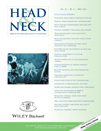Ultrasound-guided botulinum toxin injection: A simple in-office technique to improve tracheoesophageal speech in postlaryngectomy patients
Abstract
Background
Pharyngoesophageal spasm is a known entity to cause hypertonic/failed tracheoesophageal speech and is successfully treated by botulinum toxin A injection. However, success of botulinum toxin treatment is based on the accurate localization of the pharyngoesophageal segment.
Methods
A 65-year-old man who had a laryngectomy using voice prosthesis with hypertonic speech underwent ultrasonographic localization of the hypertonic pharyngoesophageal segment. The ultrasound findings were confirmed using videofluoroscopy. Under ultrasound guidance, botulinum toxin was injected into the hypertonic pharyngoesophageal segment and subsequently voice outcomes were evaluated by a speech language pathologist and the pharyngoesophageal segment was assessed by using an ultrasound scan.
Results
The patient had improvement in his postinjection tracheoesophageal puncture speech. Ultrasound scan assessment of the pharyngoesophageal segment showed adequate dilation as compared to the pre–botulinum toxin injection treatment.
Conclusion
Ultrasonographic localization of the hypertonic pharyngoesophageal segment and ultrasound-guided botulinum toxin injection is a simple, quick, and relatively cheap method to be used in routine practice. © 2011 Wiley Periodicals, Inc. Head Neck, 2013




